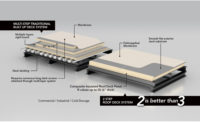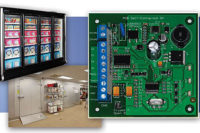Seven-step savings
Want to cut energy use in an older food plant? Savings opportunities are all around.

By Jim Short
If you’re looking to reduce energy consumption in an existing food plant, the good news is that you don’t have to look far. Savings opportunities are all around you, thanks to some new ideas, old ideas and new technologies.
Chances are, you’re also not alone. More and more companies are considering sustainability as a key process indicator. Your efforts here may positively impact everything from earnings to corporate marketing messages.
Because this article focuses on an existing facility, location and orientation issues are not easily addressed. Yet that doesn’t mean you should not consider your building’s orientation during any major retrofitting project. Sun and prevailing wind also impact energy use and any steps you take to mitigate those influences can pay dividends.
Meanwhile, here are seven indoor areas to consider.
1) LIGHTING
Windows are an old idea to provide light during the day. However, USDA and FDA limit glass applications in food plant settings. Traditional skylights have been used in past applications, but light transmission has been less than desired.
More recently, several plants are giving enthusiastic reviews to mirrored skylight tubes, which are a new and inexpensive way to harvest daylight. We also recommend high intensity fluorescent T-5 bulbs with dimmable or stepped ballasts – combined with occupancy sensors, photo cells and programmable lighting controls. Together, these technologies manage light levels at a greatly reduced cost compared to legacy lighting systems.
LED lighting technology also has advanced significantly and provides an excellent source of lighting, particularly in a cold environment. Moreover, LED represents a fraction of the power usage and maintenance costs of traditional lighting.
2) DOORS
Unfortunately, doors are a necessary evil when it comes to energy consumption. Every time a door opens, it contributes to air and vapor infiltration from room to room – creating rooms of different temperatures and air densities. It takes less than five seconds after a door is opened for the full flow of air to occur, approximately 80 fpm, or 1 mph. The greater the size of the opening and the longer the door is open, the greater the flow of air.
This infiltration of air constitutes one of the largest loads to a refrigeration system in a refrigerated facility. That’s why it’s important to (a) determine the appropriate size of the door opening, (b) analyze the speed needed for opening and closing, (c) understand frequency of use, and (d) match the door type to the application. Your options include insulated, non-insulated, sliding, overhead, and bi-parting doors depending on the application.
In some cases, it will make sense to create a vestibule with interlocking door controls to mitigate airflow from adjacent rooms. Door alignment, seal integrity around the door, and door discipline are obvious contributors to energy consumption.
3) WALLS
Like doors, wall location and composition are important factors to mitigate air and vapor transfer. A wall should be impermeable to air, structurally rigid, continuous and durable to withstand production and sanitation.
No less important than any other point on this list, it’s essential for perimeter and transition points to be well sealed to prevent air leaks. A continuous vapor barrier on the warm side of walls will mitigate infiltration. Materials of construction are varied, influenced by operations and R-value requirements.
4) COMPRESSED AIR
Air compressor systems (varying by size) can be an obvious choice to evaluate for reducing energy usage.
In this case, your starting points involve (a) noting the location of compressors with respect to surrounding air temperature and (b) minimizing conditioned air. Stabilization of the system pressure may be required to allow an evaluation of the system empirical requirements versus existing equipment capability and efficiency.
Matching dryers to requirements and utilizing “point-of-use” receivers for secondary storage further refine the system to match the system needs. Study of distribution lines for proper size, leak detection, and maintenance of filters, drain traps, lubricants, and belts all lead to a more efficient system.
5) WATER
Water and energy reduction strategies range from simple to more complex approaches, such as gray water systems. We refer to tried strategies that work. For example, we recommend that employees pick up dry loose materials before using the water hose. We also recommend CIP systems instead of manual cleaning with water hoses.
6) REFRIGERATION SYSTEMS
Food plant operators can save energy by better matching refrigeration requirements with the refrigeration system. This requires you to minimize the pressure differential in the system. Processors should (a) adjust the suction pressure, (b) keep evaporator surfaces clean and accessible to media flow and (c) use variable frequency drives (VFDs) on the evaporator fans when full design load is not needed. Lowering the discharge pressure to a minimum can also aid in reducing energy costs.
Processors should consider using a satellite hot gas compressor for defrosts and/or a booster liquid pump to maintain liquid line pressure, which will allow the condensing pressure to follow ambient conditions instead of remaining unnecessarily high, air-cooled heat exchanger for compressor oil cooling. We also recommend you consider a single set point for condensing pressure and run all condenser fans – in unison – on variable frequency drives.
Here are more energy-saving tips related to …
… compressors
Do not run multiple, partly loaded compressors (particularly screw compressors) for long periods of time. Lock one in at full load and let a single compressor on each suction level modulate. Better yet, fit a small screw compressor on each suction level with a VFD, lock the slide valve at 100 percent and modulate capacity with motor speed. Reciprocating compressors have better part-load characteristics, but the same logic generally applies.
… condensers
Make sure that heat transfer surfaces are clean, whether they involve bare tubes in evaporative condensers or finned surfaces in air-cooled units. Adjust fan belt tension to eliminate squealing and pulley damage while minimizing bearing load.
Maintain water treatment on cooling towers and other evaporative equipment.
Maintain the non-condensible gas purger in the event that system suction pressure drops below atmospheric.
… evaporators
In addition to the topics mentioned above, make sure that defrost and condensate drains function as designed. Be sure that compressor oil is not collecting in the evaporators and decreasing heat transfer performance. Processors should regularly change air filters on process and comfort air conditioning units.
… controls
Keep control valves and other mechanical devices clean and well calibrated.
… cleanliness
Employees can find small leaks of oil or refrigerant more quickly in a clean machinery room.
7) SPIRAL FREEZERS / FREEZERS / COOLERS
There are a few simple, common sense actions to improve the efficiency of spiral freezers and reduce the cost per pound to freeze product.
Typically, air balance is thought of as a food safety and condensation prevention topic. However, processors also should consider the relationship of air balance and pressurization – and its effect on spiral freezer performance. In many instances, product lines enter one side of a spiral freezer and exits the opposite side. If the areas outside the spiral freezer are not properly balanced, air will flow from one area to the other through the spiral chamber. This creates extra, non-productive load in the spiral and causes a loss of capacity due to the extra load on the coils, and quicker frosting of the coils. This also can create conditions that contribute to condensation and food safety issues.
Openings should be minimized to reduce natural infiltration. Where feasible, use air knives and other devices as an infiltration barrier. The goal is to reduce the amount of air entering the freezing chamber.
Doors should be maintained to ensure a tight seal, making sure the door edge and frame heaters are working to prevent damage to the door resulting in leaks.
Individual drains used for sequential defrost units should have individual traps to prevent warm, moist air from entering through the drain line.
The suction temperature should be at the maximum possible to permit production; lower than required suction pressure and temperature wastes energy.
Door maintenance and discipline are the most common reasons for wasted energy in coolers, freezers and conditioned docks. The use of timed closing strategies can be helpful for freezers and coolers, but not useful for manual dock doors. In areas of high traffic, rapid opening and closing doors can be useful in reducing infiltration loads on rooms.
Jim Short is director of Food & Beverage-Global Buildings North America with Jacob Engineering’s Fort Worth, Texas, office.
Other article contributors were Jim Caylor, Jacobs’ deputy director of Food & Beverage and refrigeration discipline leader; Jim Price, Jacobs’ Food & Beverage senior project manager; and Keri Sapp, a senior Jacobs electrical engineer.
Readers may contact Jacobs and the authors at (817) 222-8749 or visit www.jacobs.com
Looking for a reprint of this article?
From high-res PDFs to custom plaques, order your copy today!




